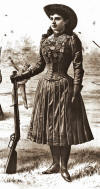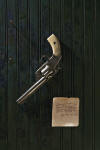AMS 105- American West: Images and Identities
|
AMS 105- American West: Images and Identities |
GUNS
One of the more romanticized and distorted images of the American West is that of the gun toting cowboy or the false notion that everyone in the West was handy with a six shooter. This image was embellished by dime novels, Wild West shows and movies. Unfortunately, kids, especially little boys, are enamored by guns. Also, the rest of the world has been influenced by the Western image of the man or woman and their gun. The individual right vs. privilege to bear arms or drive a car (horse) are still contested in many circles. Today Americans have more guns than most other countries in the world and many of them are not for sporting purposes. Since the American West was such an expansive frontier, the gun was an important tool for food and defense in a relatively lawless environment. As various explorers and pioneers headed into the West, Native Americans acquired guns into their arsenals, mostly for warfare. Initially the bow and arrow had a better rate of fire, but the invention of cartridges and repeating weapons made the gun became more efficient.
The Spaniards were the first to bring guns into the American West which included two matchlock muskets (smooth bored). One was 15-20 lbs and the other 8-10 lbs (called a arquebus or harquebus). In both cases the weapon was loaded with powder and ball from the muzzle. A fuse/match was lit and the trigger released it to touch off the powder in the pan. The lead ball was .66 to .80 caliber and the range was out to about 100 yards. These weapons were noisy and smoky which tended to bring more fear that they deserved. In fact Coronado's men in 1540 also carried crossbows, which were so effective and brutal that Pope Innocent III banned crossbows as too inhumane for Christians, but sanctioned them for heathens and infidels. The matchlock was rather sensitive to wet conditions and was replaced by the wheel lock. However, the flintlock, developed around 1625 was sturdier. The flint provided the spark in the pan to ignite the muzzle loaded charge.
When the French and English first came to America they too had wheel locks and flintlock muskets. Around 1719 German craftsmen in Pennsylvania began to rifle the barrels (cut grooves into the barrel) for greater accuracy. This had been developed earlier in Europe but was expensive and difficult to do. These Pennsylvania rifles became known as the Kentucky rife or Long rifle when early Scot-Irish pioneers adopted this weapon. These frontiersmen used the Kentucky rifle effectively in the French and Indian Wars and the Revolutionary War. In the West it was during the Lewis and Clark Expedition 1803-1806 that the men carried a mix of firearms to include Model 1795 U.S. Armory (Springfield, MA) .69 caliber muskets, Model 1803 U.S. Rifle .54 caliber and various personnel Kentucky rifles. The men on the expedition carried various other weapons including pistols, blunderbusses, swivel cannon and even an early air gun.
Mountain Men and Fur Trade
In the American West as fur trappers moved beyond the
Mississippi River they found the Kentucky rifle too delicate and long (~44
inches) and the ball of .40-.45 cal proved too light for grizzly bear and elk.
This led to the development of the 'Plains Rifle' by the Hawken family in St.
Louis. Hawken rifles averaged 34 inches long, had massive octagon barrels
bored to .50 cal. and were equipped with the new percussion system of ignition.
In the peak years of Mountain Men, like Jim Bridger and Kit Carson, the Hawken
![]() was the favorite weapon from the 1820s-1840s. Muzzleloaders continued to be used
for years, but were relatively slow at rate of fire (1-3 shots per minute) and
very difficult to reload on horseback.
was the favorite weapon from the 1820s-1840s. Muzzleloaders continued to be used
for years, but were relatively slow at rate of fire (1-3 shots per minute) and
very difficult to reload on horseback.
Breechloaders, Metallic Cartridges and Repeating Rifles
In 1811 John Hall produced the first produced a breech loading
flintlock rifle which was adopted by the U.S. Army in 1819. By 1833 a percussion
version was used by U.S. Army Dragoons in the West during the Mexican War
1846-48. The Hall rifle was plagued by problems with the breach seal and gas
leakage with an loss of muzzle velocity and dangerous explosions. In 1848
Christian Sharps developed a much tighter breech loading rifle that used that
took a paper or linen wrapped cartridge. These carbines and rifles were
percussion cap, came in .36-.52 cal. and could produce a rate of fire of about
4-5 shots per minute.![]() The Sharps was very popular and effectively became a
common rifle in the Plains where it was used extensively to kill bison and
adopted by the Army during the Civil War. However, these paper/linen cartridges
and breechloaders were still plagued by leakage problems. Inventors like Samuel
Colt and Horace Smith/Samuel Wesson were working cylinder rifles and revolvers
and metallic rim fire cartridges. This allowed for repeating weapon magazines.
The first of these was patented in 1860 by Christopher Spencer. The carbine used
a lever to eject the spent cartridge and feed a new round from a tube in the
stock and could fire seven rounds in 10 seconds, with reloading 14 rounds per
minute. Also, in 1860 B.T. Henry developed another repeating rifle that employed
a tube under the barrel to hold 15 shots. Later, Henry partnered with Oliver
Winchester to establish the New Haven Repeating Arms Company. Thus the lever
action Winchester rifle became a popular weapon in the American West beginning
with the Model 1866 and continuing with the Model 1873, Model 1876 and ending
with the 1894. These early Winchesters like the Henry had the modest .44 cal
metallic cartridge which was great for the Western landscape and operating on a
horse.
The Sharps was very popular and effectively became a
common rifle in the Plains where it was used extensively to kill bison and
adopted by the Army during the Civil War. However, these paper/linen cartridges
and breechloaders were still plagued by leakage problems. Inventors like Samuel
Colt and Horace Smith/Samuel Wesson were working cylinder rifles and revolvers
and metallic rim fire cartridges. This allowed for repeating weapon magazines.
The first of these was patented in 1860 by Christopher Spencer. The carbine used
a lever to eject the spent cartridge and feed a new round from a tube in the
stock and could fire seven rounds in 10 seconds, with reloading 14 rounds per
minute. Also, in 1860 B.T. Henry developed another repeating rifle that employed
a tube under the barrel to hold 15 shots. Later, Henry partnered with Oliver
Winchester to establish the New Haven Repeating Arms Company. Thus the lever
action Winchester rifle became a popular weapon in the American West beginning
with the Model 1866 and continuing with the Model 1873, Model 1876 and ending
with the 1894. These early Winchesters like the Henry had the modest .44 cal
metallic cartridge which was great for the Western landscape and operating on a
horse.
|
|
|
|
However, the military adopted rifles with greater firepower at the sacrifice of rate of fire. Most notably were the .45/70 rifle cartridge used in various Springfield rifles and carbines from 1873-1888. These were breech loaded weapons with a strong and reliable 'trapdoor' design. Hunting in the West still required more powerful weapons. So Sharp's trap-door, Remington's rolling bock and Ballard-Marlin's breech loader all increased cartridge sizes from the standard .45-70 to .50-70, .50-90 and .50-100 for long range and larger game.
 Model 1873 Springfield
Model 1873 Springfield |
 Remington
rolling Block Remington
rolling Block |
Pistols and Revolvers
Pistols followed the same progression from flintlock to percussion muzzle loaders to various break action breech loading weapons. The development of Samuel Colt's revolving cylinders proved the most enduring. Earlier Colt's Dragoon and Walker models were large and cumbersome. Colt, Smith and Wesson and Remington all vied for dominance of the market from the Civil War. Smith and Wesson's No. 3 and later Schofield were more sophisticated weapons. The Model 1873 U.S. Army Colt won out and was in service from 1873-1890. This Colt .45 became legendary beyond its actual popularity, but was issued in civilian circles as the "Frontier Model" or "Peacemaker". There were a number of smaller pocket guns such as derringers that were 'hide-out' guns that fired cartridges from .22-.41 cal., but their range was limited to suit close quarter use.
Guns of the Indian Wars
A considerable of misinformation abounds with arms during the
various Indian Wars in the West from 1840-1890. Initially the bow and arrow had
a better rate of fire until the advent of repeating rifles. Initially, guns were
a little used prestige item, called a fire stick. Plains Indians acquired
repeating rifles to use on horseback with war clubs and short sinew backed bows.
At the Little Bighorn fight the Cheyenne, Arapaho and Sioux possessed a mix of
guns from muzzle loaders to the latest Winchester repeaters in an array of
calibers. The 7th cavalry had issue breech loading Model 1873 Springfield
carbines .45 cal and Colt .45 cal revolvers.
 Forensic evidence at
the battlefield after a brush fire in the 1980s revealed a more accurate picture
of firing positions based on the cases and bullets used. It is clear the
Custer's immediate command of 210 was out numbered and out gunned. About 30-40%
of the 3,000-5,000 warriors had rifles and pistols to include 20% with Henry and
Winchester repeaters.
Forensic evidence at
the battlefield after a brush fire in the 1980s revealed a more accurate picture
of firing positions based on the cases and bullets used. It is clear the
Custer's immediate command of 210 was out numbered and out gunned. About 30-40%
of the 3,000-5,000 warriors had rifles and pistols to include 20% with Henry and
Winchester repeaters.
Other Native American of the West had access to guns and
learned to reload their firearms. Some were outdated and had the inherent
problems of that particular weapon and often the gun just turned into a
war club. In fact for a time spare hardwood stocks acquired from traders was
used as an effective war club often fitted with knife blades. Geronimo preferred
a large bore Sharps and would ambush soldiers by shooting the lead and rear
horses out from underneath the soldiers, then picking off the soldiers. The
chaos of wounded horses was very unnerving.![]() Sharps
Rifle
Sharps
Rifle
Gunfighters/Shootists/Desperados
The so called 'Real West' as portrayed in the movies was not what we see portrayed. The Law and Lawless was a fine line and the quick draw was almost non-existent. There was a great variety of weapons and few were good shot of fast. Getting the draw on somebody usually involved shooting them in the back and when drawing your weapon it was fired with a line of sight aim not from the hip as seen in the movies. The pistol was carried high on the hip and not low slung. Early portrayal were somewhat corrected in newer Westerns like "The Shootist" or "Appaloosa".
 Annie
Oakley
Annie
Oakley John
Wesley Hardin Colt Navy
John
Wesley Hardin Colt Navy 'Rooster
Cogburn' w/ Colt's Dragoon
'Rooster
Cogburn' w/ Colt's Dragoon Jesse
James' pistol
Jesse
James' pistol
Modern Firearms
At the end of the 19th century the modern smokeless cartridge was developed that increased the firepower. The bolt action initially handled these modern cartridges with greater firepower. The 30-06 was the most popular and was used in the military and 'sport' rifles. Gas operated from the cartridge led to semi-automatic and automatic fire arms to include the machine gun by the time of WWI.
 Model 1890 Krag
Model 1890 Krag
 Springfield
1903 Springfield
1903 |
 Browning
Water-cooled machine gun 1917 Browning
Water-cooled machine gun 1917 |